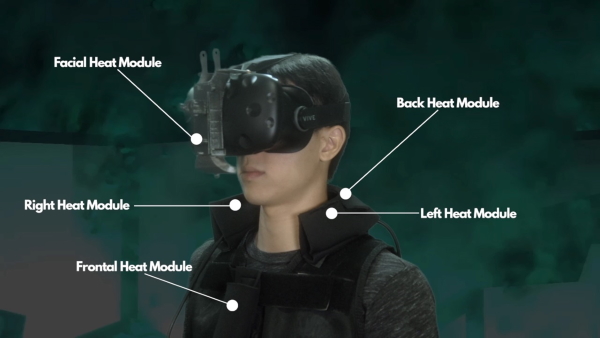[A team at the National University of Singapore has developed a virtual reality game that incorporates heat, smell and touch in a novel way likely to evoke more intense and engaging presence experiences. The story below is from NUS News, where it features a different picture and a 1:54 minute video; more information including images and a second video is available at the CUTE Center website. –Matthew]

NUS team creates interactive, multisensory VR game
14 October 2019
A team of researchers and developers from the Keio-NUS CUTE (Connective Ubiquitous Technology for Embodiments) Center at NUS has developed a novel mixed virtual reality game to bring about a unique multisensory interaction and experience for players. Four sensory streams are fused together simultaneously in a virtual reality (VR) game to achieve remarkable realism.
Called ‘The Lost Foxfire’, the 10-minute game engages a player’s senses of vision, audition (sense of hearing), olfaction (sense of smell), somatosensation (sense of touch) and thermoception (ability to sense intensity of heat). Besides relying on their vision and hearing, game players will also need to take cues from their senses of smell and touch to successfully complete the game.
Most conventional VR games use headsets and haptic bodysuits to mimic and amplify sensory feedback, for instance, to deliver the sensation of a cool breeze to match the visual scene of the moment. In contrast, the game set developed by Keio-NUS CUTE Center team brings VR multisensory bodysuits to a new level where real-time, life-like sensory feedback are used by players to make decisions that will directly impact the outcome of the gameplay.
The gameplay
In ‘The Lost Foxfire’, players take on the role of a caretaker who is left in charge of looking after an old Japanese temple for one night. However, a Foxfire spirit bride who is on her way to her wedding got lost in the temple. She wanders about the temple grounds and has the tendency to set fire to everything she touches. Players will need to save the temple from burning down by putting out the fires that the distressed Foxfire spirit has started, and catching the original spirit from its numerous decoys to stop it from starting more fires.
The hardware
The entire game system comprises a VR headset that is paired with a configurable multisensory suit that delivers thermal, wind and olfactory stimuli to the players in order to assist them in finding and, subsequently, stopping the Foxfire spirit from burning down the temple.
The adjustable suit is equipped with five heat modules that enable players to sense heat on the front, back and the sides of their necks, as well as on their faces. The thermal stimuli can be calibrated and customised to an individual’s tolerance of warmth. As players spray the original Foxfire spirit with a fire extinguisher, they will catch a whiff of the scent of apples, a favourite fruit of foxes. As players get close to the real Foxfire, they could feel the heat it emits.
“The set up for ‘The Lost Foxfire’ game system is entirely portable so it can be put up in any room. The additional sensory cues in the form of heat and smell create a more immersive gameplay environment for the players, something rarely seen in current games,” said Associate Professor Yen Ching-Chiuan, Co-Director of the Keio-NUS CUTE Center who supervises on the project.
The team comprising hardware and product engineers, artists, technology researchers and designers took nine months to develop the experimental game — from its conception, coding and building of special hardware, to graphic designing and animating. A patent has been filed for the technology behind the configurable multisensory suit.
Debut at the Tokyo Game Show’s Sense of Wonder Night 2019
‘The Lost Foxfire’ debuted at the Tokyo Game Show 2019, the world’s largest annual video game event that spotlights the latest trends and cutting-edge technologies for video games, in September 2019. ‘The Lost Foxfire’, the only project hailing from Singapore, was one of the 86 projects that were chosen from 320 independent projects around the world for the Sense of Wonder Night showcase.
Diverse Potential Applications
Although ‘The Lost Foxfire’ was first developed as an experimental game, its immersive simulation and experiential technology can be potentially extended to other applications. Besides paving the way for more immersive gaming experience to come, it could, for instance, be used to simulate unique scenarios for training purposes or to demonstrate fire safety so that users can safely experience a first-hand feel of the full scenario without the danger.
The team is open to collaboration opportunities and is currently in discussion with a few interested parties. The research is supported by the National Research Foundation, Prime Minister’s Office, Singapore under its International Research Centres in Singapore Funding Initiative.
Leave a Reply